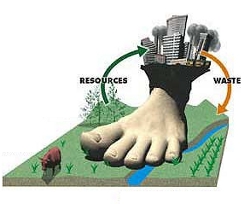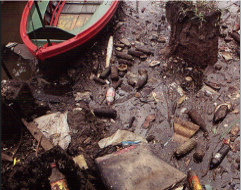The Ecological Footprint

How big are your feet?
Imagine walking barefoot along a beach, always keeping your steps on the wet sand where the waves wash up onshore. With each step, you leave a clear print; but when you look back, the water washes your footprints away. The fresh unmarked sandy beach reappears. Your human footprint seems insignificant compared to the power of Nature. But is it?
How much Nature do humans actually use? The footprint team (Rees and Wackernagel, who published Our Ecological Footprint: Reducing Human Impact on the Earth with New Society Publishers in 1996) compared different countries and cities and counted up '" all the food eaten; '" water, materials, and energy consumed; '" transportation used; *' ground built upon; *' garbage created.
They found that Canada, the United States, and many western European countries leave ecological footprints that are more than three times their fair share. If everyone on Earth had such big feet, the air, water, and soil humans need to survive couldn't refresh and recover each year.
If you live in a country with an oversized ecological footprint, chances are your personal footprint is too big. Since Nature provides everything we need and takes in all the waste we produce, it makes sense to keep our footprints within Nature's limits.
One way to reduce your ecological footprint is to cut back on garbage, which involves much more than what you throwaway. Garbage starts when you choose an item, includes how you use it, how you care for it, as well as how you dispose of it.
Wasted
What happens when people take more from Nature than they give back? History tells us. Archaeologists think oversized ecological footprints caused the collapse of some ancient civilizations, including the
• Mayans of Central America;
• Mound Builders of the Mississippi Valley;
• Khmer of Angkor in Cambodia;
• Statue Builders of Easter Island;
Here are two of the stories.
The Statue Builders of Easter Island
In 1722 western ships first anchored of this remote South Pacific island. Dutch Admiral Jacob Roggeveen recorded what he found in a journal. He observed islanders bowing down and worshipping gigantic stone figures called moai. Hundreds of look-alike moai – some as tall as 10 meters (about 12 feet) – faced inland, as if watching the island’s people. Because the island was treeless and without any material to make sturdy ropes, the admiral couldn’t imagine how the statues were created onto their stone platforms.
About fifty years later Captain Cook landed on Easter Island and found far fewer people – most of them hungry – and many of the moai toppled. By the early twentieth century, only 111 native Easter Islanders survived.
Archaeologists have tried to piece together what happened. They believe the island was uningabited until about 400 A.D., when Polynesians landed in dugout canoes. The settlers brought seeds to plant, chickens for eggs, and rats for meat. From studying old pollen grains, scientists know that when the Polynesians arrived, the lowlands were covered with huge palm forests.
It was a tropical paradise. People fished in the sea, harvested eggs from seabird colonies, cut trees and grew crops. They carved their moai from the walls of an extinct volcano and used tree trunks to roll the statues around the island.
By 1550 A.D. there were over 10,000 people on Easter Island and over 900 moai. Soon, most of the seabirds became extinct – no more bird eggs to eat – and the forests were gone. The introduced rats loved eating palm nuts, so the trees did not reseed after logging. Without trees to hold the topsoil, much of it washed into the sea and the crops began to fail. Without trees, people could not build boats to fish offshore. They became hungry, warred among themselves, and toppled their moai. The population declined sharply and some islanders resorted to cannibalism. Then slave ships arrived and kidnapped many of the survivors. Without trees, people could not build boats to escape their lost, wasted paradise.
The Anasazi of Chaco Canyon
In the 1970S, botanist Julio Betancourt scanned the ridges around Chaco Canyon, New Mexico, and wondered why there were no trees. He knew that hardy pinyon pine and juniper trees usually grow in high desert country.
On the canyon floor below, he could see the ruins of massive stone buildings, called great houses, erected by the Anasazi between 850 A.D. and 1120 A.D. The largest originally stood four stories high and contained over 650 rooms. It was framed with logs from forests 120 km (74 mi.) away. The Anasazi had not invented the wheel nor had they domesticated animals to carry heavy loads the stones and timber were all lugged by human muscle and sweat.
Beside the ruins of the great houses still lie the remains of stone dams and canals, constructed to channel rainwater to thousands of gardens that once grew corn, squash, and beans. And radiating in all directions from the canyon are hundreds of miles of smoothed paths, some as wide as a modern two-lane highway. Despite all this labor and careful construction, the Anasazi abandoned the canyon by 1150 A.D., during a prolonged drought. The question scientists kept asking was, why would people construct a monumental community in this dry, treeless canyon in the first place?
In a crevice near the ruins, Dr. Betancourt spotted an old pack-rat nest containing pine needles. He knew that pack rats don't travel far to collect scraps, so he took the nest back to his lab. In carbon dating tests, he found the nest was 1,200 years old. This
proved that pine trees must have grown close to the nest in 800 A.D. Other scientists dug into old trash dumps and found many deer bones from the time the Anasazi first came to the canyon. But, as years passed, the deer bones disappeared and gopher bones increased. It seems the Anasazi ate all the deer and had to kill smaller animals for meat.
Scientists believe the Anasazi must have cut down all the trees for firewood and to frame their first great houses. They then had to walk longer distances to find wood. And without living tree roots to draw underground water up to the surface, water became scarce in the canyon. Meanwhile, the meat supply was disappearing. When the rains didn't come, there wasn't enough water to irrigate the corn. There wasn't even enough water to drink.
Today, while the canyon no longer supports great houses and large numbers of people, it is still home to pack rats, lizards, and other creatures of the desert. Nature survived, but an Anasazi city could not.
- Published: 2012-12-31T13:54:27-08:00
- Author: Anna Krupp, Dumpsters & Roll Off Container Consultant




